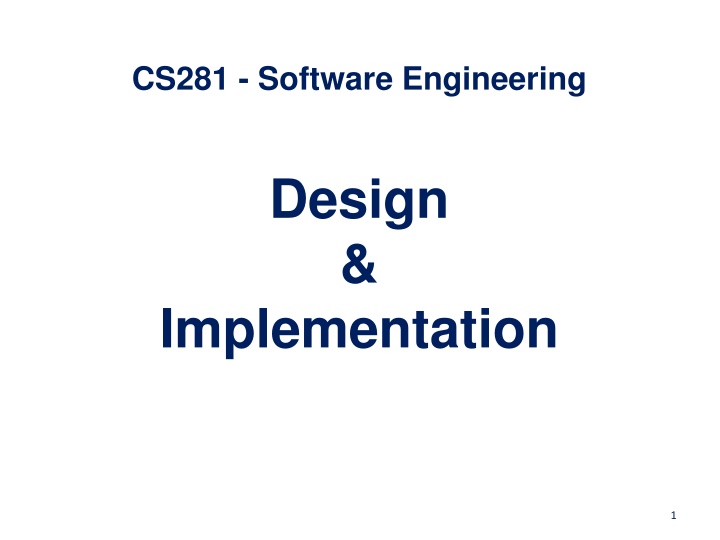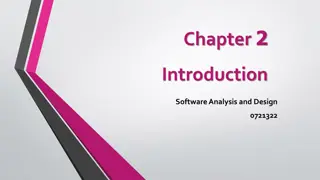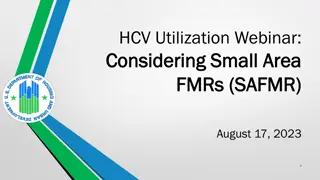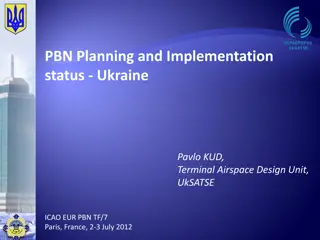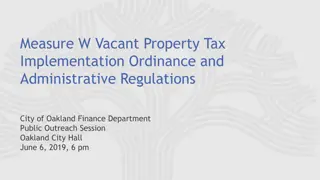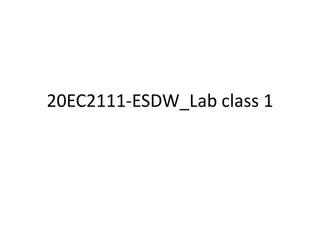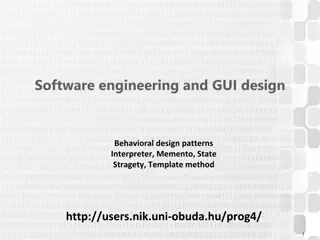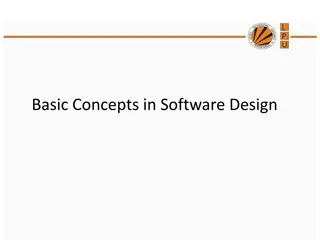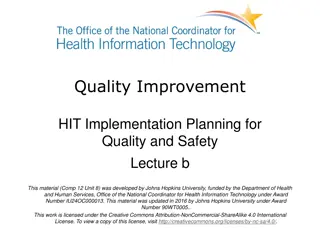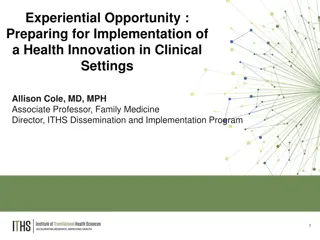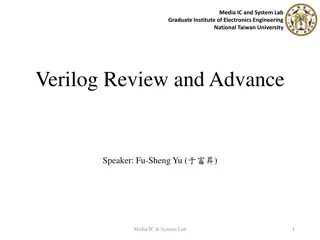Design & Implementation
Explore the principles and practices of software engineering design and implementation in CS281. Develop a deep understanding of the foundational concepts and methodologies essential for successful software development projects. Gain hands-on experience in designing and implementing software systems that meet industry standards and best practices. Enhance your skills in software architecture, coding, testing, and project management to deliver robust and high-quality software solutions.
Download Presentation

Please find below an Image/Link to download the presentation.
The content on the website is provided AS IS for your information and personal use only. It may not be sold, licensed, or shared on other websites without obtaining consent from the author.If you encounter any issues during the download, it is possible that the publisher has removed the file from their server.
You are allowed to download the files provided on this website for personal or commercial use, subject to the condition that they are used lawfully. All files are the property of their respective owners.
The content on the website is provided AS IS for your information and personal use only. It may not be sold, licensed, or shared on other websites without obtaining consent from the author.
E N D
Presentation Transcript
CS281 - Software Engineering Design & Implementation 1
So far Introduction to Software Engineering Software Processes Agile Software Development Requirements Engineering System Modeling Architectural Design Design and Implementation Source: SE9 by Ian Sommerville 2
Agenda 1. Introduction 2. Object-oriented design using the UML 3. Implementation issues 4. Open source development Source: SE9 by Ian Sommerville Chapter 7 Design and implementation 3
The Object-oriented Design (OOD) Process Structured OOD processes involve developing a number of different system models significant effort for development and maintenance of these models may not be cost-effective for small systems but rather for large systems developed by different groups, where design models are used as an important communication mechanism. There are a variety of different OOD processes that depend on the organization using the process. Source: SE9 by Ian Sommerville Chapter 7 Design and implementation 4
The Object-oriented Design (OOD) Process Cont. Common activities in these processes include: 1. Defining the context and modes of use of the system 2. Designing the system architecture 3. Identifying the principal system objects 4. Developing design models 5. Specifying object interfaces Source: SE9 by Ian Sommerville Chapter 7 Design and implementation 5
1. System Context and Interactions Understanding the relationships between the software that is being designed and its external environment is essential for deciding how to provide the required system functionality and how to structure the system to communicate with its environment. Understanding of the context also lets you establish the boundaries of the system. Setting the system boundaries helps you deciding what features are implemented in the system being designed and what features are in other subsystems. A context model: is a structural model that demonstrates the other systems in the environment of the system being developed. An interaction model: is a dynamic model that shows how the system interacts with its environment as it is used. Source: SE9 by Ian Sommerville Chapter 7 Design and implementation 6
2. Designing the System Architecture Once the interactions between the system and its environment have been understood, you use this information for designing the system architecture. You identify the major components that make up the system and their interactions, and then may organize the components using an architectural pattern, such as a layered or client-server model. Source: SE9 by Ian Sommerville Chapter 7 Design and implementation 7
3. Object Class Identification Identifying object classes is often a difficult part of OOD. There is no 'magic formula' for object identification. It relies on the skill, experience and domain knowledge of system designers. It is also an iterative process. You are unlikely to get it right first time. Approaches To Identification: Use a grammatical approach based on a natural language description of the system (used in Hood OOD method). Base the identification on tangible things in the application domain. Use a behavioural approach and identify objects based on what participates in what behaviour. Use a scenario-based analysis. The objects, attributes and methods in each scenario are identified. Source: SE9 by Ian Sommerville Chapter 7 Design and implementation 8
4. Design Models Design models show the objects and object classes and relationships between these entities. When using UML you normally develop two kinds of design models: I. Structural models describe the static structure of the system in terms of object classes and relationships. II. Dynamic models describe the dynamic structure of the system and show the interactions between the system objects. Examples Of Design Models: Subsystem models, sequence models, state machine models, and other models including use-case models, aggregation models, generalisation models, etc. Source: SE9 by Ian Sommerville Chapter 7 Design and implementation 9
Examples Of Design Models Cont. Subsystem models; show logical groupings of objects into coherent subsystems. In the UML, these are shown using packages. Sequence models; show the sequence of object interactions. State machine models; show how individual objects change their state in response to events or service requests and the state transitions triggered by these requests. You don t usually need a state diagram for all of the objects in the system. Many of the objects in a system are relatively simple and a state model adds unnecessary detail to the design. Source: SE9 by Ian Sommerville Chapter 7 Design and implementation 10
5. Interface Specification Object interfaces have to be specified so that the objects and other components can be designed in parallel. The UML class diagrams can be used for interface specification. Component interfaces must be defined precisely so that other objects can use them. A UML interface stereotype may be used to define interfaces. Source: SE9 by Ian Sommerville Chapter 7 Design and implementation 11
System context for the weather station Source: SE9 by Ian Sommerville Chapter 7 Design and implementation 13
Weather station use cases Source: SE9 by Ian Sommerville Chapter 7 Design and implementation 14
Use case descriptionReport weather System Weather station Use case Report weather Actors Weather information system, Weather station Description The weather station sends a summary of the weather data that has been collected from the instruments in the collection period to the weather information system. The data sent are the maximum, minimum, and average ground and air temperatures; the maximum, minimum, and average air pressures; the maximum, minimum, and average wind speeds; the total rainfall; and the wind direction as sampled at five-minute intervals. Stimulus The weather information system establishes a satellite communication link with the weather station and requests transmission of the data. Response The summarized data is sent to the weather information system. Comments Weather stations are usually asked to report once per hour but this frequency may differ from one station to another and may be modified in the future. Source: SE9 by Ian Sommerville Chapter 7 Design and implementation 15
High-level Architecture Of The Weather Station Source: SE9 by Ian Sommerville Chapter 7 Design and implementation 16
Architectural Design The weather station is composed of independent subsystems that communicate by broadcasting messages on a common infrastructure. Source: SE9 by Ian Sommerville Chapter 7 Design and implementation 17
Weather station description A weather station is a package of software controlled instruments which collects data, performs some data processing and transmits this data for further processing. The instruments include air and ground thermometers, an anemometer, a wind vane, a barometer and a rain gauge. Data is collected periodically. When a command is issued to transmit the weather data, the weather station processes and summarises the collected data. The summarised data is transmitted to the mapping computer when a request is received. Source: SE9 by Ian Sommerville Chapter 7 Design and implementation 18
Weather station object classes Object class identification in the weather station system may be based on the tangible hardware and data in the system: Ground thermometer, Anemometer, Barometer Application domain objects that are hardware objects related to the instruments in the system. Weather station The basic interface of the weather station to its environment. It therefore reflects the interactions identified in the use-case model. Weather data Encapsulates the summarized data from the instruments. Source: SE9 by Ian Sommerville Chapter 7 Design and implementation 19
Weather station object classes Source: SE9 by Ian Sommerville Chapter 7 Design and implementation 20
Sequence diagram describing data collection Source: SE9 by Ian Sommerville Chapter 7 Design and implementation 21
Weather station state diagram Source: SE9 by Ian Sommerville Chapter 7 Design and implementation 22
Weather station interfaces Source: SE9 by Ian Sommerville Chapter 7 Design and implementation 23
Design and Implementation Object-oriented design using the UML Implementation issues Open source development Source: SE9 by Ian Sommerville Chapter 7 Design and implementation 24
Implementation Issues * 1. Reuse: When you are developing software, you should make as much use as possible of existing code. 2. Configuration management: During the development process, you have to keep track of the many different versions of each software component in a configuration management system. 3. Host-target development: Production software does not usually execute on the same computer as the software development environment. Rather, you develop it on one computer (the host system) and execute it on a separate computer (the target system). * The focus here is not on programming, but on other implementation issues Source: SE9 by Ian Sommerville Chapter 7 Design and implementation 25
1. Reuse From the 1960s to the 1990s, most new software was developed from scratch. The only significant reuse or software was the reuse of functions and objects in programming language libraries. Costs and schedule pressure mean that this approach became increasingly unviable, especially for commercial and Internet-based systems. The reuse of existing software is an emerged approach that is now generally used for business and scientific software. Source: SE9 by Ian Sommerville Chapter 7 Design and implementation 26
Reuse levels The abstraction level At this level, you don t reuse software directly but use knowledge of successful abstractions in the design of your software. The object level At this level, you directly reuse objects from a library rather than writing the code yourself. The component level Components are collections of objects and object classes that you reuse in application systems. The system level At this level, you reuse entire application systems. Source: SE9 by Ian Sommerville Chapter 7 Design and implementation 27
Reuse costs The costs of the time spent in looking for software to reuse and assessing whether or not it meets your needs. Where applicable, the costs of buying the reusable software. For large off-the-shelf systems, these costs can be very high. The costs of adapting and configuring the reusable software components or systems to reflect the requirements of the system that you are developing. The costs of integrating reusable software elements with each other (if you are using software from different sources) and with the new code that you have developed. Source: SE9 by Ian Sommerville Chapter 7 Design and implementation 28
2. Configuration Management Configuration management is the name given to the general process of managing a changing software system. The aim of configuration management is to support the system integration process so that all developers can access the project code and documents in a controlled way, find out what changes have been made, and compile and link components to create a system. By the way, did you hear about Microsoft Visual SourceSafe (or VSS)? Source: SE9 by Ian Sommerville Chapter 7 Design and implementation 29
Configuration Management Activities Version management, where support is provided to keep track of the different versions of software components. Version management systems include facilities to coordinate development by several programmers. System integration, where support is provided to help developers define what versions of components are used to create each version of a system. This description is then used to build a system automatically by compiling and linking the required components. Problem tracking, where support is provided to allow users to report bugs and other problems, and to allow all developers to see who is working on these problems and when they are fixed. Source: SE9 by Ian Sommerville Chapter 7 Design and implementation 30
3. Host-target Development Most software is developed on one computer (the host), but runs on a separate machine (the target). More generally, we can talk about a development platform and an execution platform. A platform is more than just hardware. It includes the installed operating system plus other supporting software such as a database management system or, for development platforms, an interactive development environment. Development platform usually has different installed software than execution platform; these platforms may have different architectures. Source: SE9 by Ian Sommerville Chapter 7 Design and implementation 31
Integrated Development Environment Software development tools are often grouped to create an integrated development environment (IDE). An IDE is a set of software tools that supports different aspects of software development, within some common framework and user interface. IDEs are created to support development in a specific programming language such as Java. The language IDE may be developed specially, or may be an instantiation of a general-purpose IDE, with specific language-support tools. Source: SE9 by Ian Sommerville Chapter 7 Design and implementation 32
Design and Implementation Object-oriented design using the UML More about Design patterns Implementation issues Open source development Source: SE9 by Ian Sommerville Chapter 7 Design and implementation 33
Open Source Development Open source development is an approach to software development in which the source code of a software system is published and volunteers are invited to participate in the development process Its roots are in the Free Software Foundation (www.fsf.org), which advocates that source code should not be proprietary but rather should always be available for users to examine and modify as they wish. Open source software extended this idea by using the Internet to recruit a much larger population of volunteer developers. Many of them are also users of the code. Source: SE9 by Ian Sommerville Chapter 7 Design and implementation 34
Open source systems The best-known open source product is, of course, the Linux operating system which is widely used as a server system and, increasingly, as a desktop environment. Other important open source products are Java, the Apache web server and the mySQL database management system. Source: SE9 by Ian Sommerville Chapter 7 Design and implementation 35
Open source business More and more product companies are using an open source approach to development. Their business model is not reliant on selling a software product but on selling support for that product. They believe that involving the open source community will allow software to be developed more cheaply, more quickly and will create a community of users for the software. Source: SE9 by Ian Sommerville Chapter 7 Design and implementation 36
Open source licensing A fundamental principle of open-source development is that source code should be freely available, this does not mean that anyone can do as they wish with that code. Legally, the developer of the code (either a company or an individual) still owns the code. They can place restrictions on how it is used by including legally binding conditions in an open source software license. Some open source developers believe that if an open source component is used to develop a new system, then that system should also be open source. Others are willing to allow their code to be used without this restriction. The developed systems may be proprietary and sold as closed source systems. Source: SE9 by Ian Sommerville Chapter 7 Design and implementation 37
Questions? Source: SE9 by Ian Sommerville Chapter 1 Introduction 38
